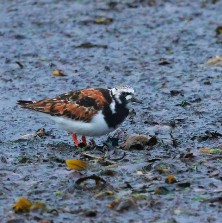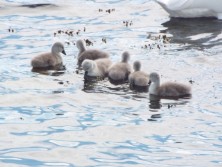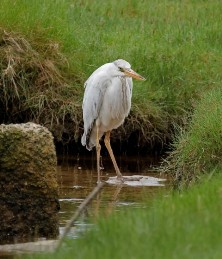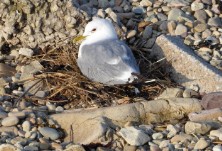May 2024
Bird Sightings



In comparison to April, May was warmer and drier. The mean temperature was four degrees higher and there was around thirty percent less rain. There was a dry warm spell between 15th and 22nd. In comparison to last May, this May was warmer and wetter. The wind was mainly from a northerly direction. Conditions did not seem particularly conducive for birds trying to get on with, although familiar garden birds seemed to be flourishing.
Throughout the month the numbers of the usual summer visitors like Swallow, House Martin, Sand Martin, Willow Warbler, Whitethroat, Sedge Warbler and Cuckoo continued to build up slowly. Cuckoo seemed to be particularly widespread and noticeable this year with small groups being reported from some areas. In contrast the reports of Tree Pipit, Spotted Flycatcher and Whinchat were sparse even towards the end of the month.
In addition to the "firsts" reported in the April notes, here are some further "firsts" in May with the 2023 arrival dates in brackets for comparison: Spotted Flycatcher, Whitefarland on 14th (18th), Garden Warbler, North Sannox on 20th (12th) and Swift, Sliddery on 22nd(7th). To date there have been no reports yet this year of Arctic Tern, Common Tern, Corncrake, Lesser Whitethroat, Nightjar, Quail or Wood Warbler.
Species who breed further north continued to pass through including: seventeen Whimbrel at Porta Buidhe on 1st, two Bar-tailed Godwit in Auchenhew Bay on 2nd, three Black-throated Diver off Cosyden on 18th, seven Great Northern Diver in Machrie Bay also on 18th and a White Wagtail in Pirnmill on 24th. On Blackwaterfoot shore over a number of days, waves of Arctic breeding shore birds provided quite a spectacle in their breeding plumage, as they stopped off to actively feed. These included eight Turnstone on 24th , eight Dunlin on 27th , thirty Sanderling on 30th , one Knot on 31st as well as the Little Stint, the first Arran report in twenty-two years. This species featured in a recent “Banner” article. It was reported among the other shore birds between 27th and 30th inclusive. In addition, the single Whooper Swan that has not migrated north but over-summered on Arran since 2018, was joined by a second Whooper Swan at Clauchlands on 29th. This second bird may be the solitary bird that was reported in the Shiskine Valley throughout the winter.
In May, breeding was well underway for many species. Encouraging signs included reports of Golden Eagle, Golden Plover, Hen Harrier, Red-throated Diver, Short-eared Owl and Long-eared Owl all holding breeding territories. Activity was reported from all the monitored heronries on the island and a small number of areas held small numbers of breeding Lapwing. The number of coastal cliffs holding nesting Fulmar continues to seriously decline. By contrast the Black Guillemot colonies seem to be thriving. The cordoned off area at Porta Buidhe seems to be again proving to be a safer breeding area for shore birds and the use of notices on other stretches of Arran’s shores seems to be having a positive effect . Other breeding records included: Great Spotted Woodpecker drumming by Stronach Wood on 2nd, Curlew and Skylark holding territories on Machrie Moor on15th, a pair of Canada Geese with five young on Sliddery Shore on 21st, a female Mallard with eight young on Mossend Pond on 24th, a pair of Shelduck with four young at Shannochie on 25th, a pair of Mute Swan with six young at Cordon on 29th and roding Woodcock over Lakin Farm on 31st . The Sand Martin colony at the entrance to Glen Catacol seems much reduced as a result of natural changes to the sand bank there.
In May over one hundred and ten species were recorded but there were no confirmed reports of Little Egret. Again, there seems to be an absence of Little Egret on Arran during the breeding season. Here are some other highlights: four Crossbill over Brodick Golf Course on 1st two Red Grouse on Dearg Choirein on 6th, a Little Grebe on Mossend Pond on 9th, four Red-throated Diver off Pirnmill on 14th, an Osprey flying over the Ross on 16th, sixty Guillemot and twenty Gannet in Machrie Bay on 18th, a Pink-footed Goose in Auchenhew Bay also on 18th, two leucistic Grey Heron photographed in Lochranza on 27th, a juvenile White-tailed Eagle over Corriecravie also on 27th and six Lesser Redpoll in Shiskine on 31st.
With the long daylight hours, it is a great time of year to be birding. Most birds are getting on with the business of breeding. Please take a moment to report any signs of breeding birds to me, but please also remember that under the Nature Conservation (Scotland


